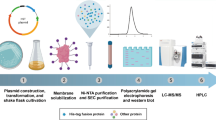Abstract
2-Hydroxymuconic semialdehyde (2-HMS) dehydrogenase catalyzes the conversion of 2-HMS to 4-oxalocrotonate, which is a step in themeta cleavage pathway of aromatic hydrocarbons in bacteria. AtomC gene that encodes 2-HMS dehydrogenase ofBurkholderia cepacia G4, a soil bacterium that can grow on toluene, cresol, phenol, or benzene, was overexpressed intoE. coli HB101, and its gene product was characterized in this study. 2-HMS dehydrogenase fromB. cepacia G4 has a high catalytic efficiency in terms of Vmax/Km towards 2-hydroxy-5-methylmuconic semialdehyde followed by 2-HMS but has a very low efficiency for 5-chloro-2-hydroxymuconic semialdehyde. However, the enzyme did not utilize 2-hydroxy-6-oxo-hepta-2, 4-dienoic acid and 2-hydroxy-6-oxo-6-phenylhexa-2,4-dienoic acid as substrates. The molecular weight of 2-HMS dehydrogenase fromB. cepacia G4 was predicted to be 52 kDa containing 485 amino acid residues from the nucleotide sequence of thetomC gene, and it exhibited the highest identity of 78% with the amino acid sequence of 2-HMS dehydrogenase that is encoded in theaphC gene ofComamonas testosteroni TA441. 2-HMS dehydrogenase fromB. cepacia G4 showed a significant phylogenetic relationship not only with other 2-HMS dehydrogenases, but also with different dehydrogenases from evolutionary distant organisms.
Similar content being viewed by others
References
Arai, H., Ohishi, T., Chang, M. Y., and Kudo, T., Arrangement and regulation of the genes formeta-pathway enzymes required for degradation of phenol inComamonas testosteroni TA441.Microbiology, 146, 1707–1715 (2000).
Folson, B. R. and Chapman, P. J., Performance characterization of a model bioreactor for the biodegradation of trichloroethylene byPseudomonas cepacia G4.Appl. Environ. Microbiol., 57, 1602–1608 (1991).
Gibson, D. T., Hensely, M., Yoshioka, H., and Mabry, T. J., Formation of (+)-cis-dihydroxy-1-methylcyclohexa-4,6-diene form toluene byPseudomonas putida. Biochemistry, 9, 1626–1630 (1970).
Harayama, S., Lehrbach, P. R., and Timmis, K. N., Transposon mutagenesis analysis ofmeta-cleavage pathway operon genes of the TOL plasmid ofPseudomonas putida mt-2.J. Bacteriol., 160, 251–255 (1984).
Hayase, N., Taira, K., and Furukawa, K.,Pseudomonas putida KF715bphABCD operon encoding biphenyl and polychlorinated biphenyl degradation: cloning, analysis and expression in soil bacteria.J. Bacteriol., 172, 1160–1164 (1990).
He, Z., Davis, J. K., and Spain, J. C., Purification, characterization, and sequence analysis of 2-aminomuconic 6-semialdehyde dehydrogenase fromPseudomonas pseudoalcaligenes JS45.J. Bacteriol., 180, 4591–4595 (1998).
Inoue, J., Shaw, J. P., Rekik, M., and Harayama, S., Overlapping substrate specificities of benzaldehyde dehydrogenase (thexylC gene product) and 2-hydroxymuconic semialdehyde dehydrogenase (thexylG gene product) encloded by TOL plasmid pWWO ofPseudomonas putida.J. Bacteriol., 177, 1196–1201 (1995).
Kang, E., Oh, J. M., Lee, J., Kim, Y. C., Min, K. H., Min, K. R., and Kim, Y., Genetic structure of thebphG gene encoding 2-hydroxymuconic semialdehyde dehydrogenase ofAchromobacter xylosoxidans KF701.Biochem. Biophys. Res. Commun., 246, 20–25 (1998).
Kim, S., Shin, H. J., Kim, Y., Kim, S. J., and Kim, Y. C., Nucleotide sequence of thePseudomonas sp. DJ77phnG gene encoding 2-hydroxymuconic semialdehyde dehydrogenase.Biochem. Biophys. Res. Commun., 240, 41–45 (1997).
Kukor, J. J. and Olsen, R. H., Genetic organization and regulation of ameta cleavage pathway for catechols produced from catabolism of toluene, benzene, phenol, and cresols byPseudomonas pikettii PKOl.J. Bacteriol., 173, 4587–4594 (1991).
Nelson, M. J. K., Montgomery, S. O., ONeil, E. J., and Pritchard, P. H., Aerobic metabolism of trichloroethylene by a bacterial isolate.Appl. Environ. Microbiol., 52, 383–384 (1986).
Oh, J. M., Kang, E., Min, K. R., Kim, C. K., Kim, Y. C., Lim, J. Y., Lee, K. S., Min, K. H., and Kim, Y., Structure of catechol 2,3-dioxygenase gene encoded in TOM plasmid ofPseudomonas cepacia G4.Biochem. Biophys. Res. Commun., 234, 578–581 (1997).
Shields, M. S., Reagin, M. J., Gerger, R. R., Campbell, R., and Somerville, C., TOM, a new aromatic degradative plasmid fromBurkholderia (Pseudomonas) cepacia G4.Appl. Environ. Microbiol., 61, 1352–1356 (1995).
Shingler, V., Powlowski, J., and Marklund, U., Nucleotide sequence and functional analysis of the complete phenol/ 3,4-dimethylphenol catabolic pathway ofPseudomonas sp. strain CF600.J. Bacteriol., 174, 711–724 (1992).
Whited, G. M. and Gibson, D. T., Toluene-4-monoxygenase, a three component enzyme system that catalyzes the oxidation of toluene top-cresol inPseudomonas mendocina KR1.J. Bacteriol., 173, 3010–3016 (1991).
Worsey, M. J. and Williams, P. A., Metabolism of toluene and xylenes byPseudomonas putida (arvilla) mt-2: evidence for a new function of the TOL plasmid.J. Bacteriol., 124, 7–13 (1975).
Author information
Authors and Affiliations
Corresponding author
Rights and permissions
About this article
Cite this article
Reddy, A.M., Min, K.R., Lee, K. et al. Kinetic property and phylogenic relationship of 2-hydroxymuconic semialdehyde dehydrogenase encoded intomC gene ofBurkholderia cepacia G4. Arch Pharm Res 27, 570–575 (2004). https://doi.org/10.1007/BF02980133
Received:
Issue Date:
DOI: https://doi.org/10.1007/BF02980133




